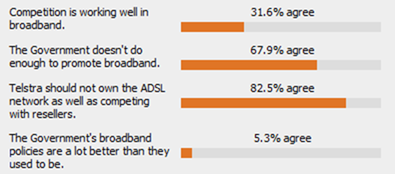Has Australia’s Opinion Changed About Internet In Australian Since 2003?
With the latest results about Australian Broadband published from Whirlpool, it got me thinking, what were people’s opinions about Broadband years ago? So I decided to look through the results of the past Whirlpool annual broadband survey results from 2003 until now. Here’s what I have found.
The Broadband Marketplace
Contracts
Between the 2003 and 2008 results, a question asked “Do you feel comfortable committing to a broadband contract longer than 6 months?” The majority of people between 2003 and 2007 said that they rather not; but in 2008, the gap between “I don’t mind”, and “I’d rather not” was only a 3% difference. Back in 2003, the gap was 11%. So that says more and more people are comfortable in committing to longer broadband contracts.
Government Involvement
In 2003, a question asked “which of the following statements do you agree with?”. I though I post the results for people to compare it with status the NBN.
I do wonder what the results would be like now if those exact same questions are asked.
Wireless Internet
When I read the results on whether or not city-wide wireless broadband is something you’d find useful, I was shocked at the results as to how much people’s mind-set has changed, especially since the development and wide use of smart phones. Amazingly 44% of people back in 2003 find that wireless city-wide broadband would not be useful, and 56% saying it will. If that question is asked today, I would be surprised if only 5% of people said wireless broadband in the city won’t be useful. I wonder if those 44% of people who said wireless broadband in the city won’t be useful, have a smart phone? Following from that, 37% of people would not be interested in a 3GB download limit for wireless internet, with 55% of people would only pay less than $100. Again, in 2011, there would be a lot of people interested in that! The year 2006 seemed to be the year when wireless began to take off as it was now being considered as a serious option for home internet access with 46% agreeing that it is.
How Broadband Is Being Used
How users are using their broadband connection back in 2003 is pretty much the same as 2010. The majority of people still have broadband due to the reasons of fast downloads, fast web surfing, and always on web access. However now, the internet is being used for much more than what it was used in the past such as downloading TV shows, online gaming, working from home, and VOIP with VOIP usage increased from 14.3% in 2004 to 37.% in 2011.
In households, 2 people frequently use the one broadband connection, and the majority of people still only have 2 computers; however there is now higher percentage of 3 or more computers sharing the same broadband connection.
Another useful fact is that in 2003, 60% shared their broadband connection through a wired connection, and 20% shared their connection both through wired and wireless. In 2011, that has greatly reversed with only 6.8% using wired only, and 74% using both wired and wireless to share their broadband connection with 2004 being the turn-around point.
Signing Up To Broadband
From 2003 until now, there hasn’t been much of a change on how people research their decision to go with an ISP. The majority is still through Whirlpool, Broadband Choice, the ISP’s website and a friend’s recommendation. However, it is by no surprise that 63% of the respondents said that in 2003, this was their first ISP broadband provider they have signed up to, compared to now with only 15.6% either still on with their first ISP or just signing up to broadband for the first time (which is quite high in my opinion). I would be interested to know how many people are still on dial-up and haven’t connected to broadband yet.
It is interesting that the average contract length in 2003 was between 1 month and 12 months (depending on the ISP). Comparing that to 2008, contract lengths are between now 7-12 months and 19-24 months.
When users are first connected to broadband, the majority of ISP’s still blame Telstra if there are any difficulties with installation. ISP’s always seem to like playing the blame game.
Payment
I would have though the payment methods would have changed since the past, but Credit/Debit cards, direct debit and B-Pay were still the dominant payment methods back in 2004.
Customer Support and Internet Reliability
Customer service levels, and service reliability have remained steady from 2003 up until today, however there are less prolonged outages as in 2003, Telstra seemed to have quite a bit with 37% of users stating their internet has been down between 1 and 3 days. If I remember correctly, Telstra did have a major outage that affected quite a number of people.
In regards to speed from the ADSL connection, the majority of users are still getting between 5-10Mbit/s, however, there are slightly more people getting a higher speed compared to pre-2005.
VOIP
Between the 2005 and 2008 survey’s, questions about VOIP were introduced. In 2005, 48% of people didn’t use VOIP but were interested in the technology, with 43% saying they’ve never heard of VOIP before. Since then, the number of people using VOIP has increased by 10% with many VOIP uses using it as their main telephone service. I wouldn’t be surprised if that number has climbed again, especially with ISP’s like iiNet offering free VOIP calls on their Naked DSL plans.
Broadband Hardware
In 2004, 22% of people used D-Link, 21% used Billion and 17% of people used Motorola hardware. Today, Billion is the leader with 24%, Netgear second with 14%, Netcomm with 9.2% and D-Link falling behind with only 8.7% market share (which is quite a large drop). The stats do show that slightly more people have received their hardware from a retail store compared to from their ISP.
Why Customers Stay and Leave Their ISP
In 2003, Speed, reliability, and pricing were the main factors on why customers stay with their ISP, and today, reliability, pricing followed by performance are the main factors. So not much different there…
In 2008, there was a trend that the amount money people are paying for broadband per month was a little too expensive, however most people now think they amount they’re paying is about right.
The reasons why customers leave their ISP back in 2003, is because the download limits were too low, or they were paying too much than what they thought they should be. In 2010, this is still the same case, as they have been reversed, but having moved residence has greatly increased on why people leave their ISP. Lower prices still remain the top reason that entices users to change ISP’s.
So The Key Changes From 2003 Until 2010?
So to come to a conclusion, here’s a short summary of the major changes of people’s opinion between broadband use between 2003 and today:
- Wireless is now more popular with more people using it compared to the past
- Before, people didn’t seem to like the idea of city-wide wireless internet – I don’t think that’s the case now
- People don’t mind to committing to longer broadband contracts
- Customer support, broadband service, and reliability are pretty much identical from 2003 till today
- Payment methods are still the same
- The top broadband hardware suppliers have changed in popularity, with D-Link loosing a large amount of market share
- More people are getting their broadband hardware from a retail store, compared from their ISP
- Broadband seemed a little expensive previously, but now people think broadband is worth what they pay for
- Why customers leave and stay with their ISP is very similar.
You can visit each years Whirlpool Annual Australian Broadband survey by visiting the following years: 2003, 2004, 2005, 2006, 2007, 2008, 2009, 2010.
What are your thoughts about the changes in Australian Broadband since 2003?




